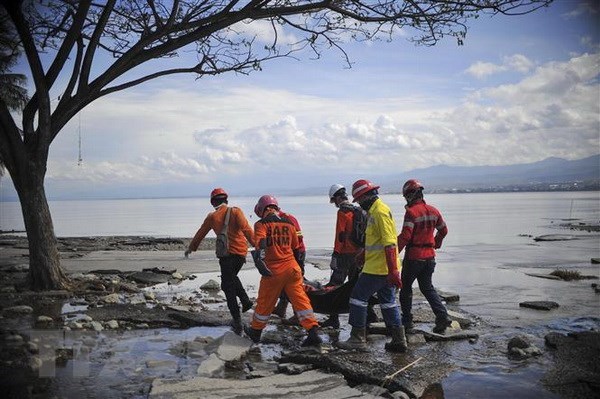
The ASEAN Coordinating Centre for Humanitarian Assistance on Disaster Management (AHA Centre) was one of the first organisations that worked with the Indonesian Government to support local people and ease impacts of recent natural disasters.

Rescuers move a body found after the earthquakes and tsunami
in Indonesia’s Central Sulawesi province (Photo: Xinhua/VNA)
Indonesia’s Central Sulawesi province was hit by 6.1-magnitude and
7.5-magnitude quakes and a subsequent tsunami on September 28, which left over
2,070 dead and around 5,000 others missing.
Director of Operations of the AHA Centre Arnel Capili said the centre has
established two working groups, one in Jakarta and one in Palu city.
The Palu group has worked with the Indonesian government and local authorities
to launch humanitarian activities and provide checkups for patients as well as
examine their living conditions, in a bid to overcome consequences of the disasters.
He also stressed that the AHA Centre focuses mainly on coordinating
humanitarian aid from countries, regional and international organisations to
support victims of the quakes and tsunami.
The centre was tasked with connecting countries and organisations which offer
aid to Indonesia with its government. Once the assistance is accepted, the
centre will distribute necessities, devices and budget for Indonesia.
The centre also works closely with national disaster management agencies of all
10 ASEAN members in monitoring and sharing information about hazards and
disasters in the region.
Additionally, it closely monitors the hazards and earth observations well as
early warning releases by hydro-meteorological and geological agencies of ASEAN
countries to build a disaster-resilient region.
It serves as a bridge linking scientists and disaster management agencies of
respectively countries, while seeking solutions to mitigate losses caused by
natural disasters.
Source: VNA
The first summit between the European Union (EU) and the Gulf Cooperation Council (GCC) in Brussels, Belgium, marked an important step forward in their bilateral relations.
The 45th General Assembly of the ASEAN Inter-Parliamentary Assembly (AIPA-45) opened in Vientiane on October 19.
Many countries are grappling with rapidly aging population. As population aging becomes an irreversible global trend with significant impacts on economic and social sectors, nations face the urgent task of creating flexible policies to adapt to and make the most of this trend to build prosperous and sustainable societies.
With a series of stimulus measures, the world tourism industry is on the way to recovery as before the COVID-19 pandemic broke out. Facing the opportunity to take off, the "smokeless industry” is expected to strongly contribute to global economic growth while promoting potential and cohesion, contributing to peace and sustainable development.
The danger from the COVID-19 pandemic is still latent, threatening people’s health and lives in the context that the immunity provided from the COVID-19 vaccine has decreased. Many other dangerous diseases are also likely to break out when the global vaccination rate slows down, due to inequality in access to health services, vaccine hesitancy, and consequences of economic recession.
The Association of Southeast Asian Nations (ASEAN) is witnessing a rise in the sales of electric vehicles (EVs) in Vietnam, Malaysia and Indonesia, according to Maybank Investment Bank Research (Maybank IB Research).



